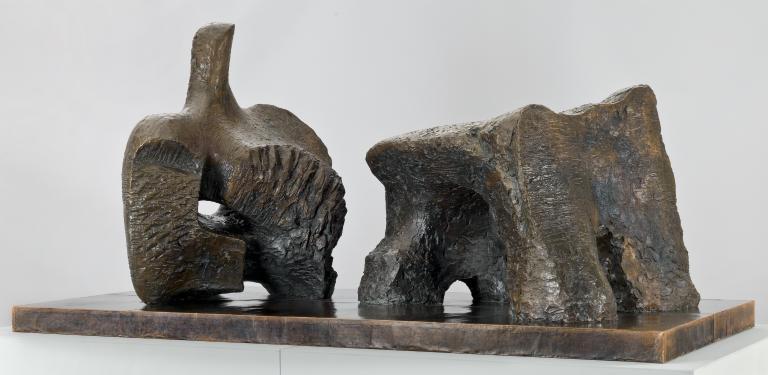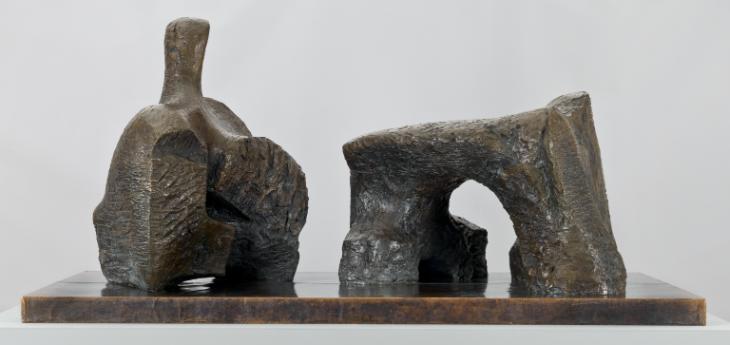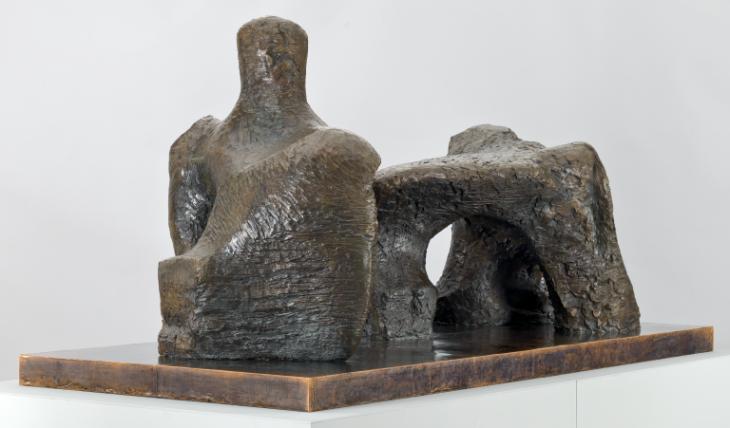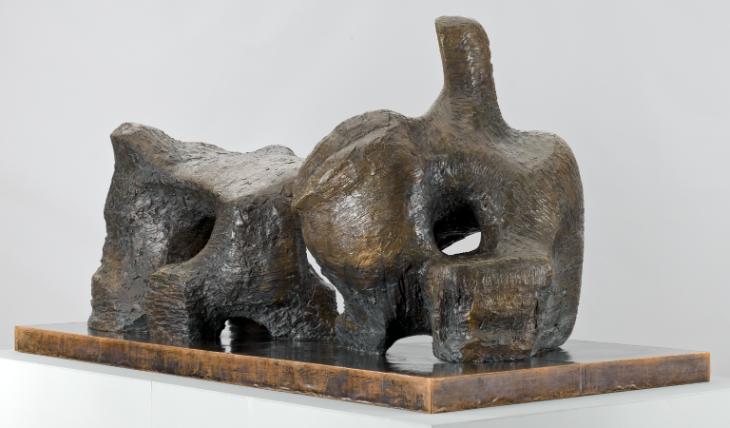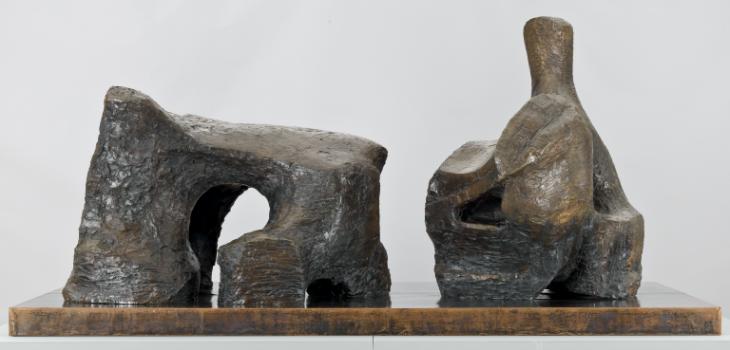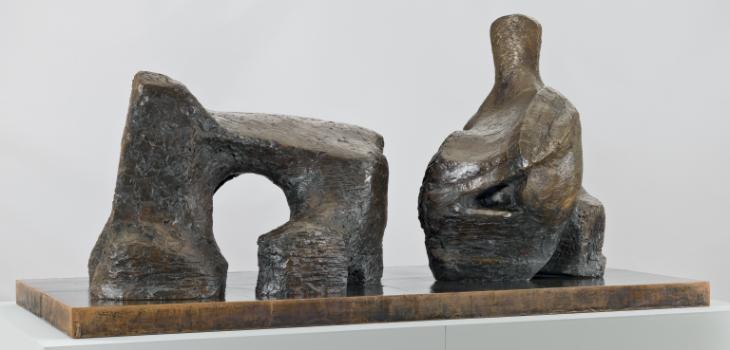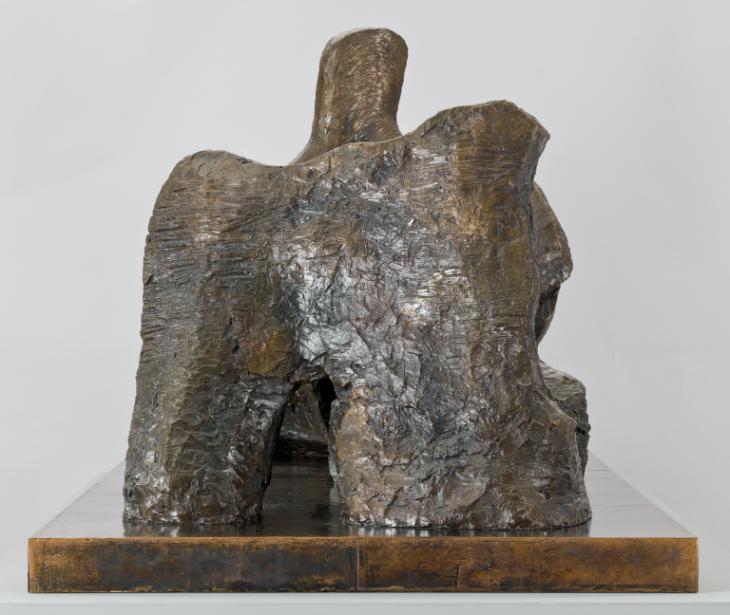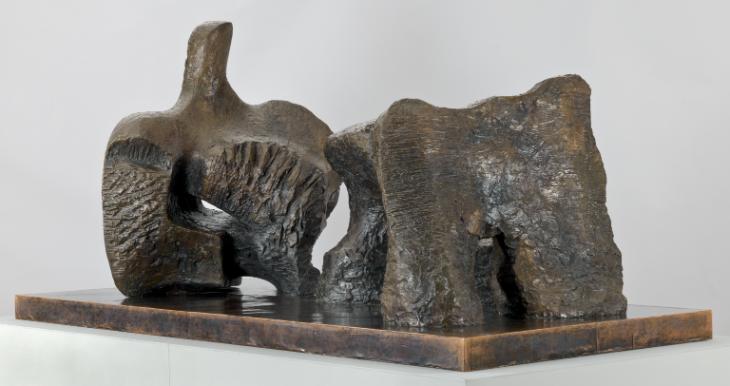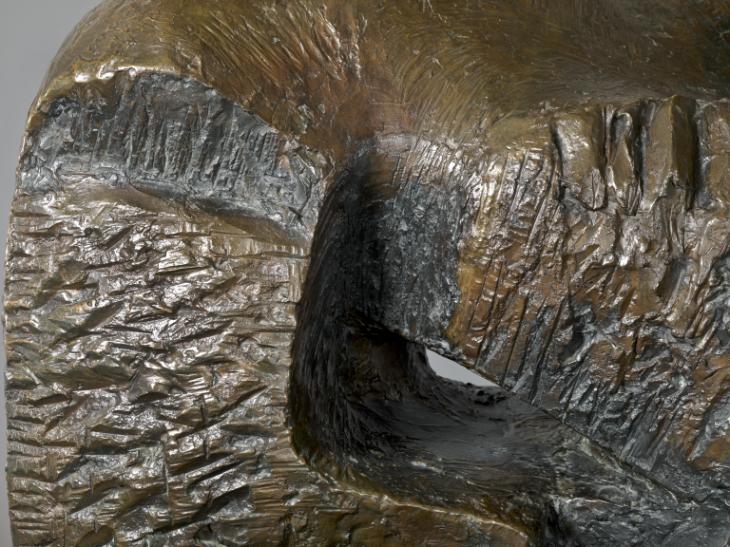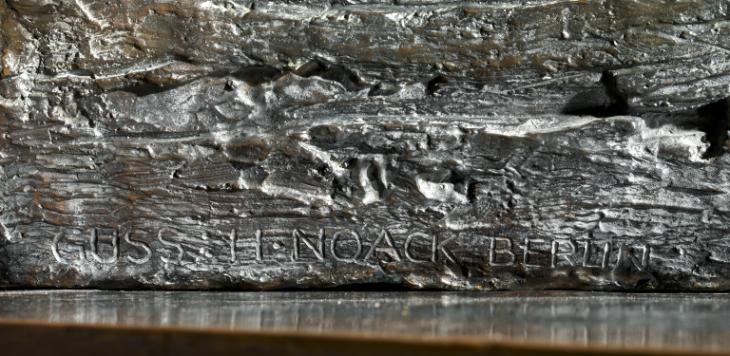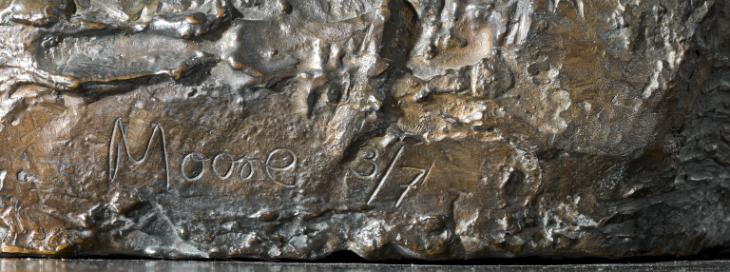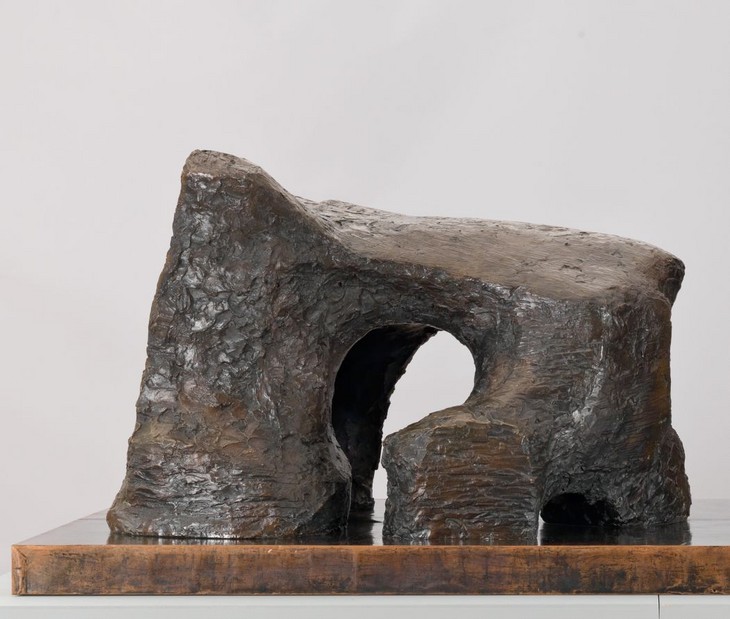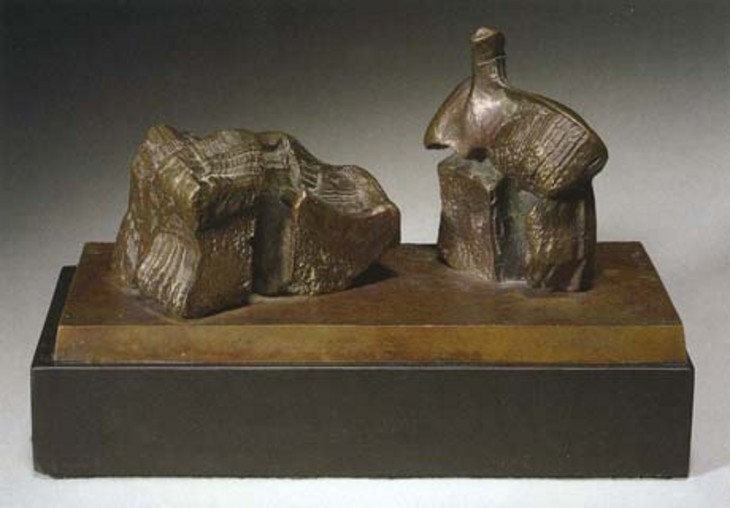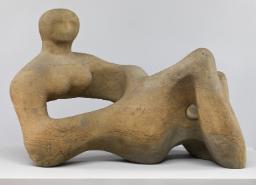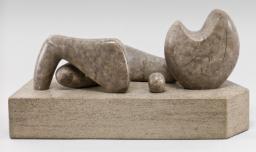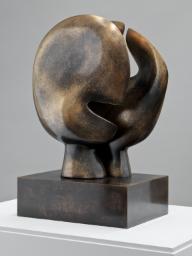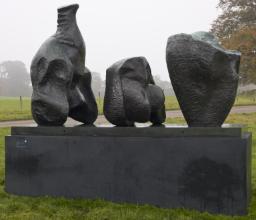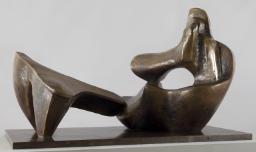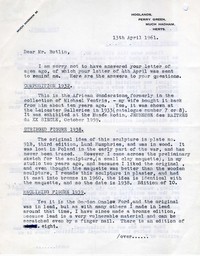Henry Moore OM, CH Two Piece Reclining Figure No.2 1960, cast 1961-2
Image 1 of 15
-
 Henry Moore OM, CH, Two Piece Reclining Figure No.2 1960, cast 1961-2© The Henry Moore Foundation. All Rights Reserved© The Henry Moore Foundation. All Rights Reserved
Henry Moore OM, CH, Two Piece Reclining Figure No.2 1960, cast 1961-2© The Henry Moore Foundation. All Rights Reserved© The Henry Moore Foundation. All Rights Reserved -
 Henry Moore OM, CH, Two Piece Reclining Figure No.2 1960, cast 1961-2© The Henry Moore Foundation. All Rights Reserved© The Henry Moore Foundation. All Rights Reserved
Henry Moore OM, CH, Two Piece Reclining Figure No.2 1960, cast 1961-2© The Henry Moore Foundation. All Rights Reserved© The Henry Moore Foundation. All Rights Reserved -
 Henry Moore OM, CH, Two Piece Reclining Figure No.2 1960, cast 1961-2© The Henry Moore Foundation. All Rights Reserved© The Henry Moore Foundation. All Rights Reserved
Henry Moore OM, CH, Two Piece Reclining Figure No.2 1960, cast 1961-2© The Henry Moore Foundation. All Rights Reserved© The Henry Moore Foundation. All Rights Reserved -
 Henry Moore OM, CH, Two Piece Reclining Figure No.2 1960, cast 1961-2© The Henry Moore Foundation. All Rights Reserved© The Henry Moore Foundation. All Rights Reserved
Henry Moore OM, CH, Two Piece Reclining Figure No.2 1960, cast 1961-2© The Henry Moore Foundation. All Rights Reserved© The Henry Moore Foundation. All Rights Reserved -
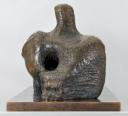 Henry Moore OM, CH, Two Piece Reclining Figure No.2 1960, cast 1961-2© The Henry Moore Foundation. All Rights Reserved© The Henry Moore Foundation. All Rights Reserved
Henry Moore OM, CH, Two Piece Reclining Figure No.2 1960, cast 1961-2© The Henry Moore Foundation. All Rights Reserved© The Henry Moore Foundation. All Rights Reserved -
 Henry Moore OM, CH, Two Piece Reclining Figure No.2 1960, cast 1961-2© The Henry Moore Foundation. All Rights Reserved© The Henry Moore Foundation. All Rights Reserved
Henry Moore OM, CH, Two Piece Reclining Figure No.2 1960, cast 1961-2© The Henry Moore Foundation. All Rights Reserved© The Henry Moore Foundation. All Rights Reserved -
 Henry Moore OM, CH, Two Piece Reclining Figure No.2 1960, cast 1961-2© The Henry Moore Foundation. All Rights Reserved© The Henry Moore Foundation. All Rights Reserved
Henry Moore OM, CH, Two Piece Reclining Figure No.2 1960, cast 1961-2© The Henry Moore Foundation. All Rights Reserved© The Henry Moore Foundation. All Rights Reserved -
 Henry Moore OM, CH, Two Piece Reclining Figure No.2 1960, cast 1961-2© The Henry Moore Foundation. All Rights Reserved© The Henry Moore Foundation. All Rights Reserved
Henry Moore OM, CH, Two Piece Reclining Figure No.2 1960, cast 1961-2© The Henry Moore Foundation. All Rights Reserved© The Henry Moore Foundation. All Rights Reserved -
 Henry Moore OM, CH, Two Piece Reclining Figure No.2 1960, cast 1961-2© The Henry Moore Foundation. All Rights Reserved© The Henry Moore Foundation. All Rights Reserved
Henry Moore OM, CH, Two Piece Reclining Figure No.2 1960, cast 1961-2© The Henry Moore Foundation. All Rights Reserved© The Henry Moore Foundation. All Rights Reserved -
 Henry Moore OM, CH, Two Piece Reclining Figure No.2 1960, cast 1961-2© The Henry Moore Foundation. All Rights Reserved© The Henry Moore Foundation. All Rights Reserved
Henry Moore OM, CH, Two Piece Reclining Figure No.2 1960, cast 1961-2© The Henry Moore Foundation. All Rights Reserved© The Henry Moore Foundation. All Rights Reserved -
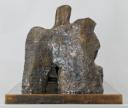 Henry Moore OM, CH, Two Piece Reclining Figure No.2 1960, cast 1961-2© The Henry Moore Foundation. All Rights Reserved© The Henry Moore Foundation. All Rights Reserved
Henry Moore OM, CH, Two Piece Reclining Figure No.2 1960, cast 1961-2© The Henry Moore Foundation. All Rights Reserved© The Henry Moore Foundation. All Rights Reserved -
 Henry Moore OM, CH, Two Piece Reclining Figure No.2 1960, cast 1961-2© The Henry Moore Foundation. All Rights Reserved© The Henry Moore Foundation. All Rights Reserved
Henry Moore OM, CH, Two Piece Reclining Figure No.2 1960, cast 1961-2© The Henry Moore Foundation. All Rights Reserved© The Henry Moore Foundation. All Rights Reserved -
 Henry Moore OM, CH, Two Piece Reclining Figure No.2 1960, cast 1961-2© The Henry Moore Foundation. All Rights Reserved© The Henry Moore Foundation. All Rights Reserved
Henry Moore OM, CH, Two Piece Reclining Figure No.2 1960, cast 1961-2© The Henry Moore Foundation. All Rights Reserved© The Henry Moore Foundation. All Rights Reserved -
 Henry Moore OM, CH, Two Piece Reclining Figure No.2 1960, cast 1961-2© The Henry Moore Foundation. All Rights Reserved© The Henry Moore Foundation. All Rights Reserved
Henry Moore OM, CH, Two Piece Reclining Figure No.2 1960, cast 1961-2© The Henry Moore Foundation. All Rights Reserved© The Henry Moore Foundation. All Rights Reserved -
 Henry Moore OM, CH, Two Piece Reclining Figure No.2 1960, cast 1961-2© The Henry Moore Foundation. All Rights Reserved© The Henry Moore Foundation. All Rights Reserved
Henry Moore OM, CH, Two Piece Reclining Figure No.2 1960, cast 1961-2© The Henry Moore Foundation. All Rights Reserved© The Henry Moore Foundation. All Rights Reserved
© The Henry Moore Foundation. All Rights Reserved
Henry Moore OM, CH,
Two Piece Reclining Figure No.2
1960, cast 1961-2
© The Henry Moore Foundation. All Rights Reserved
The craggy appearance of this sculpture, coupled with Moore’s decision to split the upper body and legs of the reclining figure into two separate parts, allows representations of the human body to coalesce with those of the natural landscape, which developed from Moore’s interest in weathered rocks and nineteenth-century French paintings of cliffs and arches.
Henry Moore OM, CH 1898–1986
Two Piece Reclining Figure No.2
1960, cast 1961–2
Bronze
1250 x 2900 x 1375 mm
Inscribed ‘Moore 3/7’ and ‘Guss H Noack Berlin’ on torso
Purchased 1960
Number 3 in an edition of 7 plus 1 artist’s copy
T00395
Two Piece Reclining Figure No.2
1960, cast 1961–2
Bronze
1250 x 2900 x 1375 mm
Inscribed ‘Moore 3/7’ and ‘Guss H Noack Berlin’ on torso
Purchased 1960
Number 3 in an edition of 7 plus 1 artist’s copy
T00395
Ownership history
Purchased from the artist (Grant-in-Aid) 1960.
Exhibition history
1973
Henry Moore to Gilbert & George: Modern British Art from the Tate Gallery, Palais des Beaux-Arts, Brussels, September–November 1973, no.42.
1978
The Henry Moore Gift, Tate Gallery, London, June–August 1978, no number.
1981
Henry Moore: Sculptures, Drawings, Graphics 1921–1981, Palacio de Velázquez, Palacio de Cristal and Parque de El Retiro, Madrid, May–August 1981, no.175.
1981
Henry Moore, Fundação Calouste Gulbenkian, Lisbon, September–November 1981, no.88.
1988
Henry Moore, Royal Academy of Arts, London, September–December 1988, no.178.
1989
Henry Moore, Fondation Pierre Gianadda, Martigny, May–November 1989, no number.
References
1960–1
Henry Moore: Sculpture 1950–1960, exhibition catalogue, Whitechapel Gallery, London 1960 (?another cast reproduced no.70).
1963
Edgar Wind, Art and Anarchy, London 1963 (?another cast reproduced pl.14).
1965
Dennis Farr, British Sculpture Since 1945, London 1965, reproduced pl.1.
1965
Herbert Read, Henry Moore: A Study of His Life and Work, London 1965, pp.226–35, reproduced pl.214.
1967
Henry Moore, exhibition catalogue, Art Gallery of Ontario, Toronto 1967, reproduced.
1967
V.M. Hillyer, Sculpture, London 1967, pp.112–15.
1968
John Hedgecoe (ed.), Henry Moore, London 1968 (another cast reproduced pp.348–9, 381, plaster in progress reproduced pp.344–7).
1969
Henry Moore Exhibition in Japan, 1969, exhibition catalogue, National Museum of Modern Art, Tokyo 1969, reproduced (two views).
1970
Robert Melville, Henry Moore: Sculpture and Drawings 1921–1969, London 1970, p.29, reproduced pls.583, 585–8.
1971
Jack Burnham, The Structure of Art, New York 1971, pp.100–1.
1973
John Russell, Henry Moore, London 1973, reproduced pl.118.
1973
Henry Moore to Gilbert & George: Modern British Art from the Tate Gallery, exhibition catalogue, Palais des Beaux-Arts, Brussels 1973, reproduced p.52.
1976
David Finn, Henry Moore: Sculpture and Environment, New York 1976 (other casts reproduced pp.174–5, 288–91).
1977
Henry Moore: Sculptures et dessins, exhibition catalogue, Musée de l’Orangerie des Tuileries, Paris 1977, reproduced pp.118–19.
1978
Henry Moore: 80th Birthday Exhibition, exhibition catalogue, Cartwright Hall, Bradford 1978 (another cast reproduced).
1978
The Henry Moore Gift, exhibition catalogue, Tate Gallery, London 1978, reproduced p.44.
1981
Henry Moore: Sculptures, Drawings, Graphics 1921–1981, exhibition catalogue, Palacio de Velázquez, Madrid 1981, reproduced p.156, pls.333–4.
1986
Alan Bowness (ed.), Henry Moore. Volume 3: Sculpture and Drawings 1955–64, 1965, revised edn, London 1986, no.458 (?another cast reproduced pls.94–7).
1987
Henry Moore and Landscape, exhibition catalogue, Yorkshire Sculpture Park, West Bretton 1987 (another cast reproduced p.20).
1989
Henry Moore al Castello Sforzesco, exhibition catalogue, Castello Sforzesco, Milan 1989, pp.xix–xxvi.
1989
Henry Moore, exhibition catalogue, Fondation Pierre Gianadda, Martigny 1989 (another cast reproduced pp.192–3).
1993
David Cohen, Henry Moore in the Bagatelle Gardens, Paris, Paris 1993, pls.33–4.
2002
Henry Moore: Rétrospective, exhibition catalogue, Fondation Maeght, Saint-Paul 2002, reproduced pp.178–9.
2006
David Mitchinson (ed.), Celebrating Moore: Works from the Collection of the Henry Moore Foundation, London 2006, pp.263–5.
2006
Henry Moore, exhibition catalogue, Fundació ‘la Caixa’, Barcelona 2006.
(another cast reproduced p.152).
2007
Jeremy Lewison, Henry Moore 1898–1986, Cologne 2007 (another cast reproduced p.84).
2008
Christa Lichtenstern, Henry Moore: Work-Theory-Impact, London 2008 (another cast reproduced pls.301, 357).
2011
Anita Feldman and Malcolm Woodward, Henry Moore: Plasters, London 2011 (full-size plaster reproduced pls.100–1).
2012
Henry Moore: Large Late Forms, exhibition catalogue, Gagosian Gallery, London 2012 (another cast reproduced pp.15, 87–91, full-size plaster reproduced pp.32–3).
Technique and condition
This is a large two-part bronze sculpture of a reclining figure. Moore would have made the original model for this sculpture by applying successive layers of plaster to a supportive armature, probably constructed from wood and metal. Marks on the surface show how Moore modified the texture of the plaster by exploiting its properties while it was setting: wet plaster would have been freely applied using a spatula and, as it began to set, deep grooves were made in its surface. There are also many parallel striations, perhaps made using a surform tool or grater when the plaster was ‘cheese hard’, as well as a number of fine grooves created by filing the surface when it was completely dry. Moore also appears to have chipped away at particular areas of the dry plaster, utilising the techniques of direct carving to give these surfaces a craggy appearance. An example of this can be seen on the figure’s right elbow (fig.1).
When the plaster had fully hardened a mould was taken from it and used to make a hollow cast in bronze. Close examination of the surface reveals the presence of casting investment in crevices in the surface of the sculpture, which suggest that the sculpture was cast using the lost wax method. This would have required the foundry to cast the bronze in multiple sections before welding them together to form the whole. The welds were carefully filed down and textured with punch tools to match the height and appearance of the original surface, a process known as ‘chasing’.
After cleaning, the surface of the bronze was coloured using an artificial patina. This process involved the application of chemical solutions to the surface that reacted with the bronze to produce coloured compounds. In this case the patina is a variegated dark brown with reddish-brown accents appearing in some areas and patches of dark green in its crevices. This would likely have required at least three different chemical solutions in varying concentrations to have been applied to the surface.
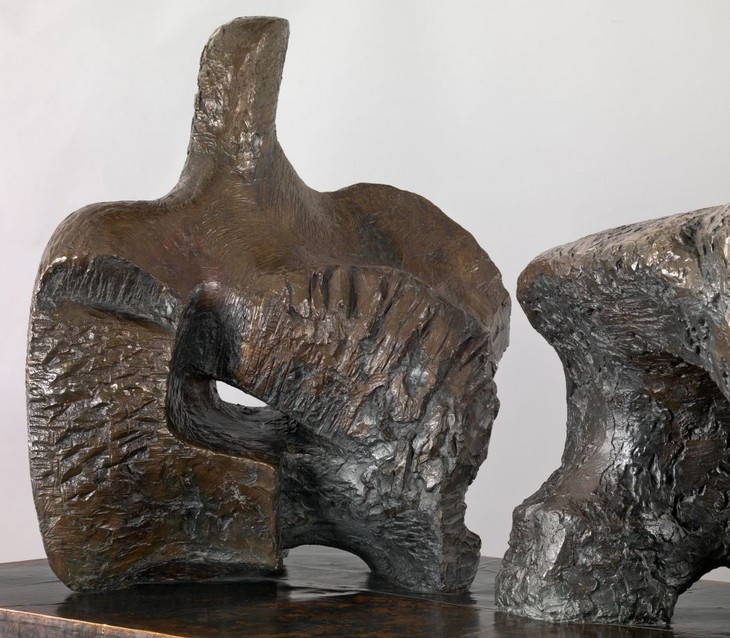
Detail of Two Piece Reclining Figure No.2 1960, cast 1961–2 showing textured surface
Tate T00395
© The Henry Moore Foundation. All Rights Reserved
Fig.1
Detail of Two Piece Reclining Figure No.2 1960, cast 1961–2 showing textured surface
Tate T00395
© The Henry Moore Foundation. All Rights Reserved
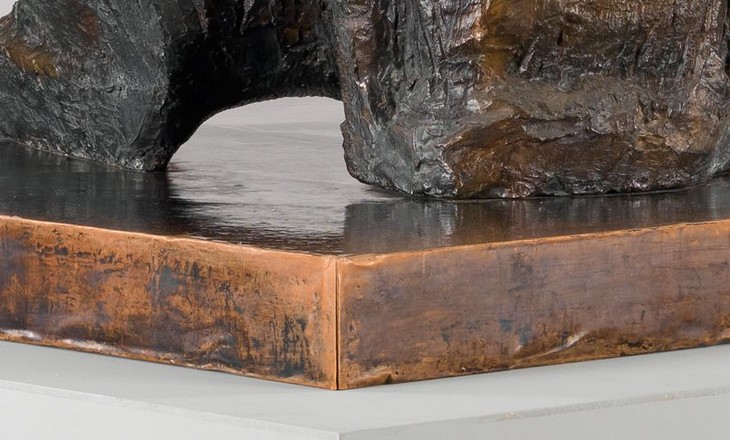
Detail of base of Two Piece Reclining Figure No.2 1960, cast 1961–2
Tate T00395
© The Henry Moore Foundation. All Rights Reserved
Fig.2
Detail of base of Two Piece Reclining Figure No.2 1960, cast 1961–2
Tate T00395
© The Henry Moore Foundation. All Rights Reserved
The sculpture is fixed to a rectangular wooden base, the visible surfaces of which have been covered with copper. Two strips of copper sheet run the length of the base and are joined along its centre. The copper has also been chemically patinated and has a dark brown finish (fig.2). In addition, texture has been added to the copper using a punch tool, creating numerous rows of small indentations in its surface. The figure’s torso is attached to the base with two bolts fixed from underneath, whereas the lower body is attached with three bolts.
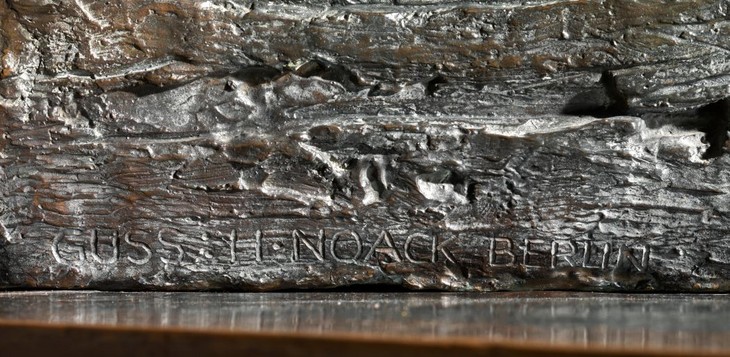
Detail of foundry stamp on Two Piece Reclining Figure No.2 1960, cast 1961–2
Tate T00395
© The Henry Moore Foundation. All Rights Reserved
Fig.3
Detail of foundry stamp on Two Piece Reclining Figure No.2 1960, cast 1961–2
Tate T00395
© The Henry Moore Foundation. All Rights Reserved

Detail of artist's signature and edition number on Two Piece Reclining Figure No.2 1960, cast 1961–2
Tate T00395
© The Henry Moore Foundation. All Rights Reserved
Fig.4
Detail of artist's signature and edition number on Two Piece Reclining Figure No.2 1960, cast 1961–2
Tate T00395
© The Henry Moore Foundation. All Rights Reserved
This sculpture was cast at Noack Foundry in West Berlin in an edition of seven plus one artist’s copy. The founder’s mark, ‘GUSS: H. NOACK BERLIN’, can be found on the lower edge of the torso behind the right elbow (fig.3). The artist’s signature and edition number ‘Moore 3/7’ is engraved on the lower edge of the torso towards the left side (fig.4).
Lyndsey Morgan
March 2013
How to cite
Lyndsey Morgan, 'Technique and Condition', March 2013, in Alice Correia, ‘Two Piece Reclining Figure No.2 1960, cast 1961–2 by Henry Moore OM, CH’, catalogue entry, July 2013, in Henry Moore: Sculptural Process and Public Identity, Tate Research Publication, 2015, https://wwwEntry
This sculpture is the second in a series of four large-scale, two-piece sculptures of reclining figures that Moore made between 1959 and 1961 (although Moore did go on to create additional two-piece sculptures later in his career). The subject of the reclining figure was a major preoccupation of Moore’s. In this work the bronze figure has been divided into two separate parts positioned on a copper base: one rises vertically to a central point and may be understood to represent a head, shoulders and torso, while the other takes the form of a block-like arch and occupies the position of legs, bent at the knees.
The head of the figure is rendered as a thin, upright protrusion emerging from a broad horizontal ridge representing shoulders. It does not bear any facial features but has a flatter, smoother side that appears to be turned towards the left shoulder, which curves sharply downwards to the base (fig.1). The right shoulder extends down to form a recognisable arm shape, bent at the elbow so that the forearm rests on the base. The curve of this arm is accentuated by a hole that pierces the centre of the torso, while a shallow arch lifts the centre of the body off the base.

Detail of Two Piece Reclining Figure No.2 1960, cast 1961–2 showing textured surface
Tate T00395
© The Henry Moore Foundation. All Rights Reserved
Fig.1
Detail of Two Piece Reclining Figure No.2 1960, cast 1961–2 showing textured surface
Tate T00395
© The Henry Moore Foundation. All Rights Reserved
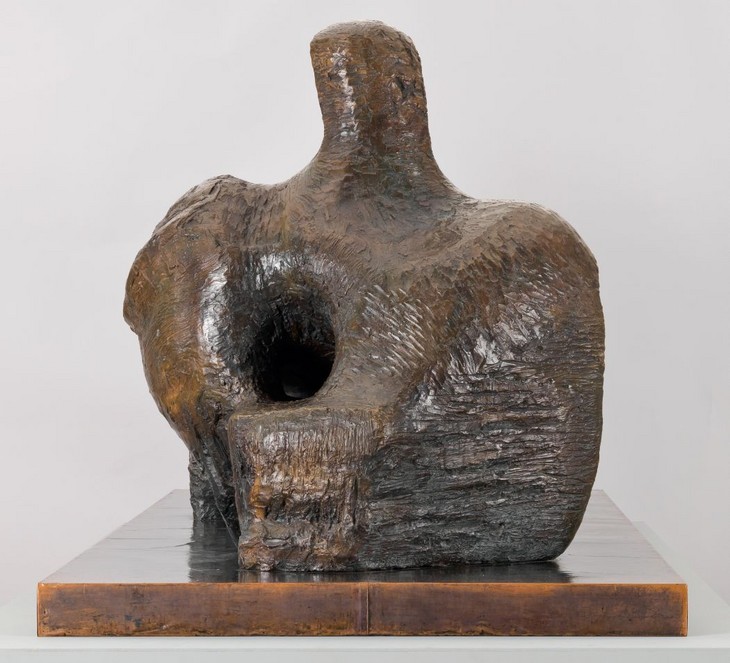
Detail of head and torso of Two Piece Reclining Figure No.2 1960, cast 1961–2 (side view)
Tate T00395
© The Henry Moore Foundation. All Rights Reserved
Fig.2
Detail of head and torso of Two Piece Reclining Figure No.2 1960, cast 1961–2 (side view)
Tate T00395
© The Henry Moore Foundation. All Rights Reserved
When seen in the round, however, the identification of singular figurative forms is brought into question. From the other side of this part of the sculpture a series of forms project away from the central mass and appear to suggest an alternative ‘front’ view (fig.2). Here the shoulders extend outwards and curve around the central hole like schematic arms, one of which stretches to the base into a block-like form reminiscent of a fist.
The other section of the sculpture comprises four irregular columns that curve smoothly into arches of varying size and form an uneven upper surface or plateaux (fig.3). Unlike the other section of the sculpture this part bears no distinct figurative features, although in relation to it may be understood to represent thighs merged into a single surface, which slant upwards into two peaked knees before descending into calves. However, the overall shape and proportions of these forms serve to challenge figurative associations; the width of the two adjacent upright forms appear incompatible with the shape of the calves while the exaggerated arch between them makes any direct analogy with the body difficult.
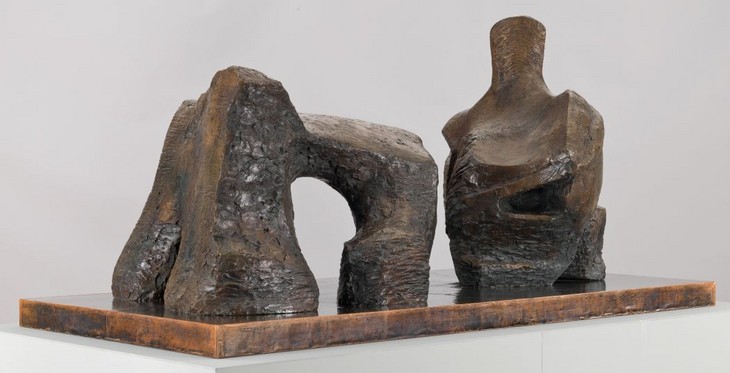
Henry Moore
Two Piece Reclining Figure No.2 1960, cast 1961–2 (rear angle view)
Tate T00395
© The Henry Moore Foundation. All Rights Reserved
Fig.4
Henry Moore
Two Piece Reclining Figure No.2 1960, cast 1961–2 (rear angle view)
Tate T00395
© The Henry Moore Foundation. All Rights Reserved
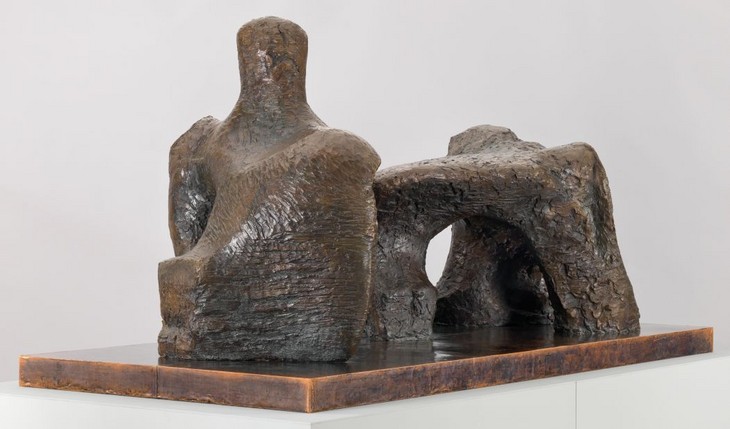
Henry Moore
Two Piece Reclining Figure No.2 1960, cast 1961–2 (front angle view)
Tate T00395
© The Henry Moore Foundation. All Rights Reserved
Fig.5
Henry Moore
Two Piece Reclining Figure No.2 1960, cast 1961–2 (front angle view)
Tate T00395
© The Henry Moore Foundation. All Rights Reserved
Indeed, the need to make imaginative leaps in order to establish a coherent image of the body appears to have shaped a number of Moore’s formal decisions. The gap separating the two parts of this sculpture and the use of arches and hollows point to the importance of negative space as something that unites as well as divides the various elements of the sculpture (fig.4). This is particularly emphasised when moving around it. For instance the two sections can be seen to overlap from certain angles, seemingly closing the gap between them (fig.5). When this occurs, the hole in the upper body and the arched space between the legs suggest new, interactive relationships between individual elements.
It is worth noting that although Moore’s large-scale reclining figures are usually identified as female, the gender of the figure is not stated in the title nor easily ascertained by looking at the sculpture itself.
From plaster to bronze
Moore began developing ideas for two-piece reclining figures in 1959 with a series of small maquettes. When discussing the first of these sculptures a few years later Moore admitted ‘I didn’t do any preliminary drawings for these. I wish now I had’.1 It is likely that he made them in the maquette studio on the grounds of his home, Hoglands, at Perry Green in Hertfordshire. This studio was lined with shelves displaying Moore’s ever growing collection of found bones, shells and pebbles, the shapes of which often served as starting points for Moore’s formal experiments in three dimensions. In 1968 Moore explained to the photographer John Hedgecoe that:
I like this little studio. I am always very happy there. I like the disarray, the muddle and the profusion of possible ideas in it. It means that whenever I go there, within five minutes I can find something to do which may get me working in a way that I hadn’t expected and cause something to happen that I hadn’t foreseen.2
The maquette for Two Piece Reclining Figure No.2 was made in 1960 and Moore went on to produce numerous additional maquettes for two-piece sculptures over the subsequent year. Some of these, such as Two Piece Reclining Figure: Maquette No.1 1960 (fig.6), were cast in bronze at their original size, but not all of them were scaled up into full-size sculptures. Moore explained:
Sometimes I make ten or twenty maquettes for every one that I use in a large scale – the others may get rejected. If a maquette keeps its interest enough for me to want to realise it as a full-size final work, then I might make a working model in an intermediate size, in which changes will be made before going to the real, full-sized sculpture. Changes get made at all these stages.3
The small maquette for Two Piece Reclining Figure No.2 is believed to have been lost or destroyed and was not cast in bronze.4 Nevertheless, it would have played a vital role in finalising the design for the sculpture and enlarging it to full scale. The enlargement process would probably have been carried out in the White Studio, also situated in the grounds of Hoglands, by Moore’s sculpture assistants, who in 1960 were Phillip King and Clive Sheppard. Recounting his time working for Moore in 2006 King stated that ‘I think I worked on Two Piece Reclining Figure for a while’.5
In order to make the full-size plaster from which the bronze was cast, Moore and his assistants would have initially constructed a wooden armature to the required size and shape for each section of the sculpture. The armature for the head and torso section was made up of numerous lengths of wood, which were then draped or wrapped in scrim, a bandage-like fabric (fig.7). Layers of plaster could be applied to the structure while the interior of the armature remained hollow. The armature for the leg section of the sculpture was constructed from chicken wire, wooden rods and scrim (fig.8). However, Moore eventually recognised that chicken wire ‘caused immense trouble when I made alterations which are always necessary in enlarging the maquettes into a full size sculpture’.6 Because the wire was difficult to cut through it also caused difficulties at the foundry, where large scale plasters had to be carved up into manageable sections for casting.
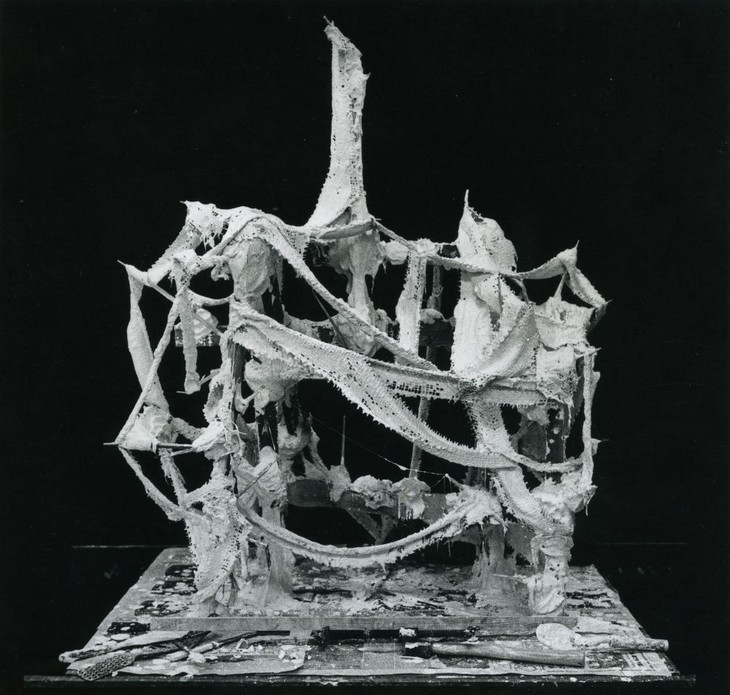
Photograph of armature for torso of Two Piece Reclining Figure No.2 1960
© The Henry Moore Foundation. All Rights Reserved
Fig.7
Photograph of armature for torso of Two Piece Reclining Figure No.2 1960
© The Henry Moore Foundation. All Rights Reserved
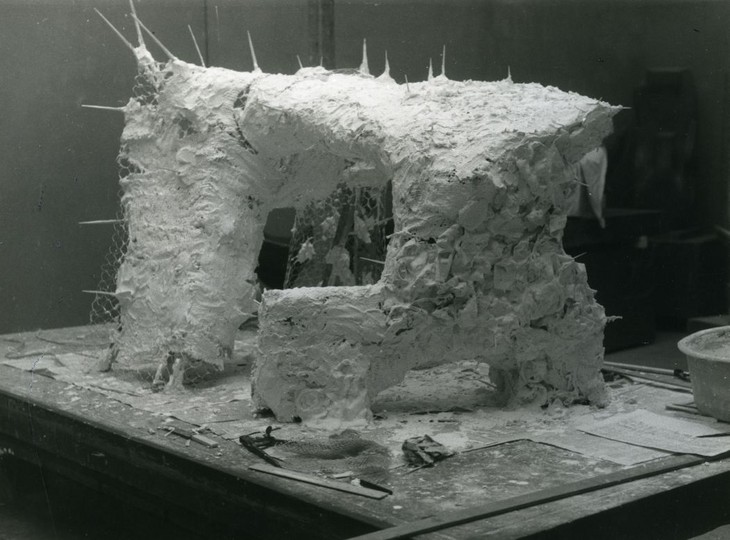
Photograph of plaster leg section of Two Piece Reclining Figure No.2 1960
© The Henry Moore Foundation. All Rights Reserved
Fig.8
Photograph of plaster leg section of Two Piece Reclining Figure No.2 1960
© The Henry Moore Foundation. All Rights Reserved
Moore’s assistants would have completed most of the preliminary work for Two Piece Reclining Figure No.2, including applying successive layers of plaster to the armature and scrim until only a short section of each armature rod was exposed (fig.8). The armature did not only serve a structural purpose; the end of each rod corresponded to a point on the surface of the sculpture as measured and multiplied from the maquette. Moore explained that ‘once they [the assistants] have brought the work within an inch or so of the measurements I intend it to be, I take it over, and then it becomes a thing I’m working on as it would if I had brought it to that stage myself’.7
During the final stage of working on the plaster Moore began to work into the surface of the sculpture. Different marks and textures could be achieved depending on the varying wetness of the plaster as it dried. Moore found plaster to be a very useful material because it could be ‘both built up, as in modelling, or cut down, in the way you carve stone or wood’.8 King noted that ‘He must have liked to work with an axe or a sort of rather heavy-bladed knife of some sort. You could see the hack marks of the instrument, and a depression would suddenly make a lot of sense’.9 In this way Moore would have been able to add and subtract material in order to achieve the precise variations in surface texture he desired. As the critic Herbert Read observed in 1965, ‘The figure is modelled in plaster and then cast in bronze, and the rough markings of the scraped and chiseled plaster are taken up by the bronze, giving the figure a rugged appearance’.10
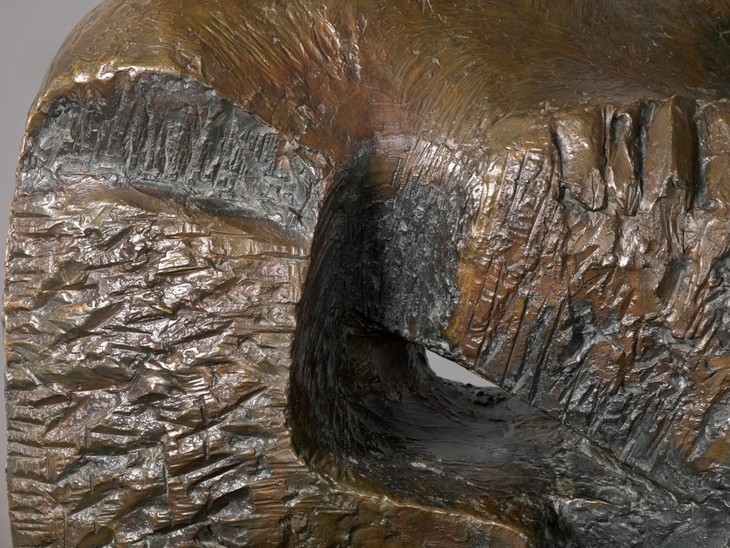
Detail of Two Piece Reclining Figure No.2 showing surface texture 1960, cast 1961–2
Tate T00395
© The Henry Moore Foundation. All Rights Reserved
Fig.9
Detail of Two Piece Reclining Figure No.2 showing surface texture 1960, cast 1961–2
Tate T00395
© The Henry Moore Foundation. All Rights Reserved
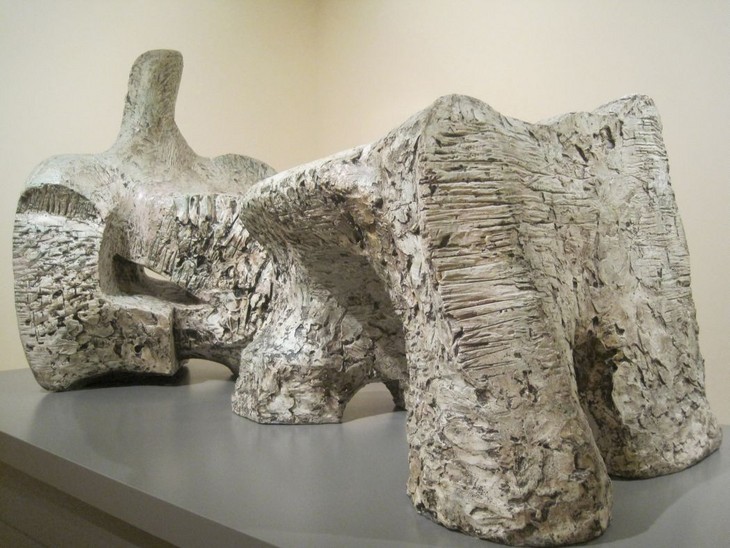
Henry Moore
Two Piece Reclining Figure No.2 1960
© The Henry Moore Foundation. All Rights Reserved
Fig.10
Henry Moore
Two Piece Reclining Figure No.2 1960
© The Henry Moore Foundation. All Rights Reserved
The surface texture of the sculpture illustrates how Moore exploited the material qualities of plaster to create distinct surface effects. Some areas of the sculpture have been given a smooth finish by applying wet plaster with a spatula, while deep grooves and parallel striations have been made in other surfaces (fig.9). These marks would likely have been made with sharp tools when the plaster had partially dried. When it was completely dry the surface could have been filed down to create smaller, finer grooves.
Moore applied colour to the surface of the full-size plaster when it was complete (fig.10) because, as he explained to the critic David Sylvester in 1963, the reflective qualities of white plaster could lend the sculpture an appearance that would be radically different when cast in bronze.11 Plaster could cast reflected light onto the underside and recessed areas of sculptures, whereas in bronze these areas would appear far darker. Painting the plaster thus allowed Moore to predict the contrast between different areas of the sculpture’s surface before sending it to the foundry.
In 1960 the finished full-size plaster was sent to the Noack Foundry in West Berlin to be cast in bronze. During the 1950s and early 1960s Moore used a number of different foundries in London and Paris, but started working with Noack in 1958 following an introduction by the dealer Harry Fischer.12 By the 1950s the Noack Foundry was regarded as one of the best foundries equipped to undertake large-scale bronze castings. Moore dealt with its owner Herman Noack directly and paid for the casting of his sculptures himself. In 1967 Moore stated: ‘I use the Noack foundry for casting most of my work because in my opinion, Noack is the best bronze founder I know ... Also, the Noack foundry is reliable in all ways – in keeping to dates of delivery – and in sustaining the quality of their work’.13
It is likely that Noack used the lost wax technique to cast the bronze sculpture. This would have required the foundry to carve up the plaster into sections and create moulds from each piece. The inside of each mould would then be ‘greased’ with a releasing agent before molten wax was poured into it. Once the wax had hardened it could be released from the mould, forming an exact replica of the sculpture in wax. The wax would then be encased in a hard refractory material, placed in a kiln and heated until it melted. Channels within the casing would allow the wax to drain away and, once empty, the cavity was filled with molten bronze. When the bronze had hardened its casing was removed, revealing a section of sculpture. After every piece of the sculpture had been cast in this way they would be welded together. Finally, the casting seams would have been filed down until the joints between each section of the cast were practically imperceptible.
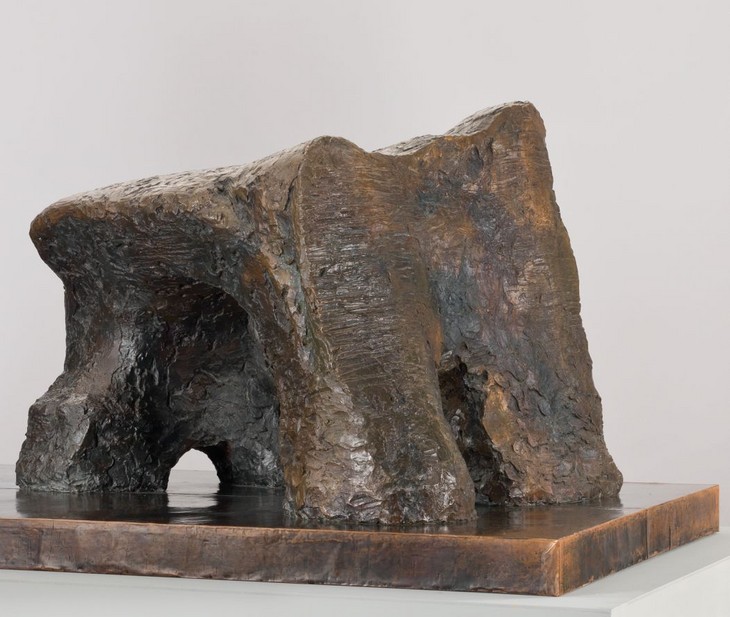
1960, cast 1961–2 Detail of patina on the leg section of Two Piece Reclining Figure No.2
Tate T00395
© The Henry Moore Foundation. All Rights Reserved
Fig.11
1960, cast 1961–2 Detail of patina on the leg section of Two Piece Reclining Figure No.2
Tate T00395
© The Henry Moore Foundation. All Rights Reserved
Sources and development
When Two Piece Reclining Figure No.2 entered the Tate collection in 1960 Moore wrote to Martin Butlin, the Assistant Keeper of the collection, stating, ‘I am enclosing some notes I wrote a month or two ago about the No.1 Two Piece Reclining Figure ... I have slightly amended the notes to refer to both the 1959 and 1960 figures as both figures are very much complementary to each other’.16 Moore’s statement read:
In 1933 and 1934 I made many sculptures composed of two, three and sometimes four pieces.
They were done partly to concentrate on the distances between forms – but also to consider the shape of the spaces between forms.
In doing these Reclining Figure sculptures, (No.1 in 1959 and No.2 in 1960), it came naturally and without any conscious decision, that I made them in two separate pieces – the head-and-body end – and the leg-end.
In both sculptures I realised that I was simplifying the essential elements of my reclining figure theme ... In many of my reclining figures the head-and-neck part of the sculpture, sometimes the torso part too, is upright, giving contrast to the horizontal direction of the whole sculpture. Also in my reclining figures, I have often made a sort of looming leg – the top leg in the sculpture projecting over the lower leg, which gives a sense of thrust and power – as a large branch of a tree might move outwards from the main trunk – or as a seaside cliff might overhang from below, if you are on the beach.
A great asset of sculpture in the round, (as against relief sculpture or painting), is its possibility of an infinite number of different views, giving, in changing lights, a never ending interest and surprise.
The two separated forms produce a greater variety of views from all aspects – for as you walk round the sculpture one form gets in front of the other, in ways that cannot be anticipated, resulting in many unexpected, unforeseen views. In that sense, I think these sculptures are more fully in the round than any previous work of mine.
Being in two pieces the work separates itself from seeming to be only a representation of a reclining figure.
Both these sculptures are a mixture, an amalgamation of the human body with rock-forms and with landscape, and so like a metaphor in poetry giving to each element a new aspect, and perhaps a new meaning.17
They were done partly to concentrate on the distances between forms – but also to consider the shape of the spaces between forms.
In doing these Reclining Figure sculptures, (No.1 in 1959 and No.2 in 1960), it came naturally and without any conscious decision, that I made them in two separate pieces – the head-and-body end – and the leg-end.
In both sculptures I realised that I was simplifying the essential elements of my reclining figure theme ... In many of my reclining figures the head-and-neck part of the sculpture, sometimes the torso part too, is upright, giving contrast to the horizontal direction of the whole sculpture. Also in my reclining figures, I have often made a sort of looming leg – the top leg in the sculpture projecting over the lower leg, which gives a sense of thrust and power – as a large branch of a tree might move outwards from the main trunk – or as a seaside cliff might overhang from below, if you are on the beach.
A great asset of sculpture in the round, (as against relief sculpture or painting), is its possibility of an infinite number of different views, giving, in changing lights, a never ending interest and surprise.
The two separated forms produce a greater variety of views from all aspects – for as you walk round the sculpture one form gets in front of the other, in ways that cannot be anticipated, resulting in many unexpected, unforeseen views. In that sense, I think these sculptures are more fully in the round than any previous work of mine.
Being in two pieces the work separates itself from seeming to be only a representation of a reclining figure.
Both these sculptures are a mixture, an amalgamation of the human body with rock-forms and with landscape, and so like a metaphor in poetry giving to each element a new aspect, and perhaps a new meaning.17
According to the art historian Alan Bowness, ‘1958 does look increasingly like a watershed ... From this date forward Moore has seemed more inclined to please himself, exploiting all the possibilities of working on a grand scale that were now open to him as a successful sculptor’.18 Despite asserting that this moment marked a turning point in Moore’s practice, Bowness nonetheless aligned it with Moore’s earlier sculptural innovations, noting that this new phase involved breaking up ‘the bronze reclining figures into two and three separate parts, reverting to an idea adumbrated in the 1930s but never developed’.19
One of Moore’s most well-known sculptures of the 1930s is Four-Piece Composition: Reclining Figure 1934 (T02054; fig.12), in which the body of the figure is separated into four parts. In 1968 Moore explained that in 1933–4 ‘I began separating forms from each other in order to be able to relate space and form together’.20 Although this retrospective explanation of the 1934 work may have been influenced by the two- and three-piece sculptures Moore was making at the time, it nonetheless suggests a degree of formal continuity between bodies of work made almost thirty years apart.
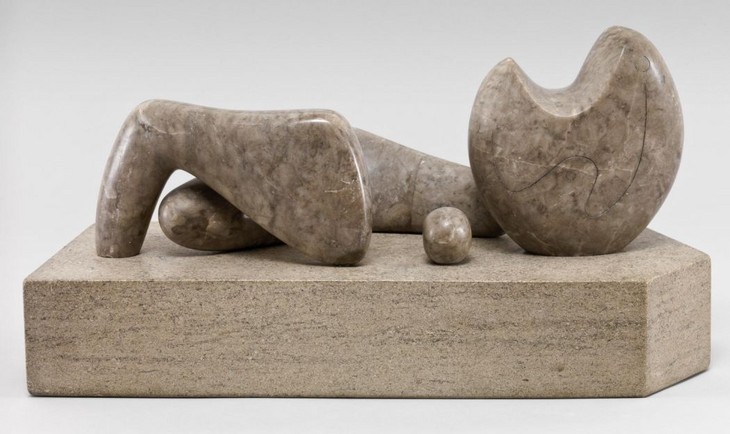
Henry Moore
Four-Piece Composition: Reclining Figure 1934
Tate T02054
© The Henry Moore Foundation. All Rights Reserved
Fig.12
Henry Moore
Four-Piece Composition: Reclining Figure 1934
Tate T02054
© The Henry Moore Foundation. All Rights Reserved
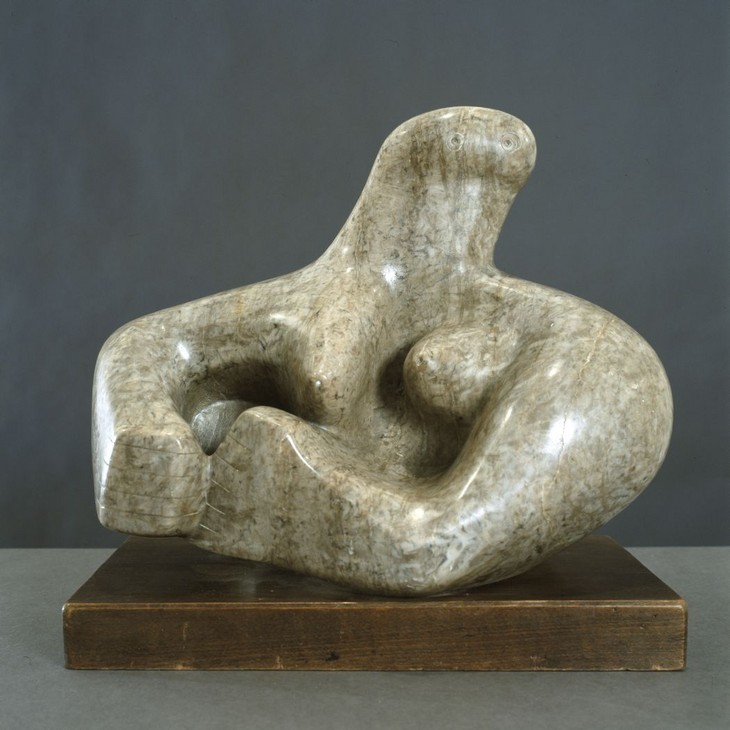
Henry Moore
Composition 1931
Cumberland alabaster
The Henry Moore Foundation
© The Henry Moore Foundation. All Rights Reserved
Photo: Michael Phipps, Henry Moore Foundation Archive
Fig.13
Henry Moore
Composition 1931
The Henry Moore Foundation
© The Henry Moore Foundation. All Rights Reserved
Photo: Michael Phipps, Henry Moore Foundation Archive
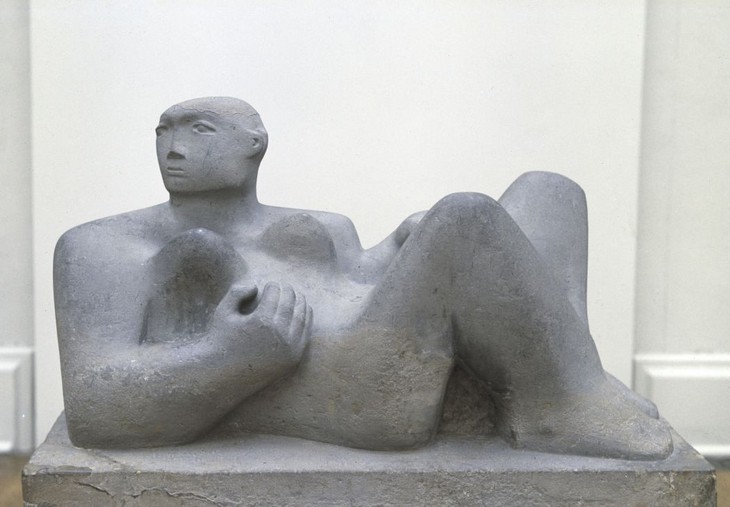
Henry Moore
Reclining Woman (Mountains) 1930
Green Hornton stone
National Gallery of Canada, Ottawa
© The Henry Moore Foundation. All Rights Reserved
Fig.14
Henry Moore
Reclining Woman (Mountains) 1930
National Gallery of Canada, Ottawa
© The Henry Moore Foundation. All Rights Reserved
In addition to the multi-part sculptures of the 1930s, formal affinities may be identified between Two Piece Reclining Figure No.2 and Moore’s small sculpture Composition 1931 (fig.13). The back of the head and torso of the bronze sculpture (fig.2) bears a strong resemblance to the earlier work, which was carved from Cumberland alabaster. Although Composition is less than forty centimetres tall, the proportions of its rounded shoulders and the space formed between the body and the large arm stretching across it relate closely to this view of Two Piece Reclining Figure No.2.
The analogies that Moore drew in his letter to Butlin between features of the body and natural formations, such as branches and cliffs, also find a precedent in earlier works by Moore. For example, the title of Reclining Woman (Mountains) 1930 alludes to the undulating landscape suggested by its head, breasts and knees (fig.14). Discussing Two Piece Reclining Figure No.2 in 1962 Moore explained that ‘I realised what an advantage a separated two-piece composition could have in relating figures to landscape. Knees and breasts are mountains. Once these two parts become separated you don’t expect it to be a naturalistic figure; therefore, you can justifiably make it like a landscape or a rock’. 21 Reflecting on this allusion to landscapes in 1965, the critic David Thompson wrote, ‘I think it could be claimed that Moore is the first sculptor in history to have found a way of expressing his feelings about landscape. Formerly only painters could describe mountains and cliffs and sea-caves’.22 The critic Robert Melville was willing to go further in 1970 when he suggested that, rather than making analogies between the female reclining body and landscapes as he did in Reclining Woman (Mountains), Moore’s two- and three-piece sculptures actually present landscapes which recall the female form: ‘They are images of rocky landscapes which bear an ‘accidental’ resemblance to woman’.23
In his statement to Butlin Moore identified a ‘looming leg’ projecting into space as a feature common to his two-piece sculptures of 1959 and 1960. From certain angles the interior leg, which separates into two feet, appears to thrust into the transitional space between the two pieces of the sculpture (fig.15). The slanted projection of the outer legs supplements this notion, as Moore recognised when he stated that the sculpture appeared as if it was ‘overhanging a seaside cliff’.24 In 1968 Moore was more explicit in his analogy, stating that the leg section of Two Piece Reclining Figure No.2 ‘began to remind me, towards its completion, of Monet’s painting of the “Cliffs at Etretat” [fig.16]. I kept thinking of this arch as if it was coming out of the sea’.25 For Moore to identify a specific work of art by another artist as having influenced the forms of his sculpture was unusual. As the critic Peter Fuller noted, ‘he manifested an almost compulsive need to ablate the memory of these artists who had a significant short range influence on him, preferring to admit to have learned only from the likes of Michelangelo and Masaccio’.26 It is possible that Moore felt comfortable acknowledging his interest in Claude Monet’s The Manneporte (Étretat) 1883 as the Frenchman was not only a canonical artist but a painter rather than a sculptor.

Henry Moore
Two Piece Reclining Figure No.2 1960, cast 1961–2 (rear angle view)
Tate T00395
© The Henry Moore Foundation. All Rights Reserved
Fig.15
Henry Moore
Two Piece Reclining Figure No.2 1960, cast 1961–2 (rear angle view)
Tate T00395
© The Henry Moore Foundation. All Rights Reserved
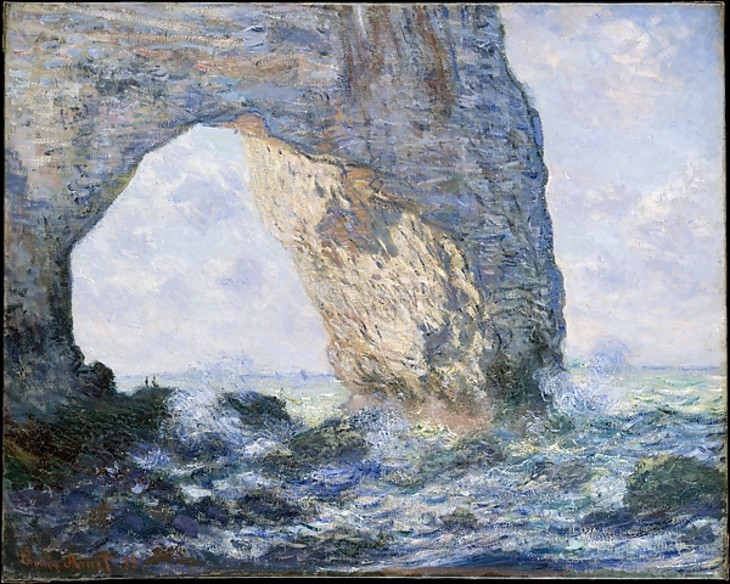
Claude Monet
The Manneporte (Étretat) 1883
Oil paint on canvas
654 x 813 mm
Metropolitan Museum of Art, New York
© 2000–2015 The Metropolitan Museum of Art. All rights reserved
Fig.16
Claude Monet
The Manneporte (Étretat) 1883
Metropolitan Museum of Art, New York
© 2000–2015 The Metropolitan Museum of Art. All rights reserved
Moore’s comment regarding Monet’s painting was recorded in 1968 but had probably been shared with other critics at an earlier date. Thompson referred to the paintings of Étretat by Courbet, Monet and Renoir in his 1965 essay on Moore’s use of landscape forms. In the same year the art historian Herbert Read remarked that from certain angles the leg section has ‘a distinct resemblance to the cliffs at Étretat so often painted by Courbet and other French artists. The torso is pierced by a cave-like hole, and adds to the cliff-life appearance’.27 But while Read, like Moore, noted similarities between these impressionist paintings and the shape of the arched leg, few critics commented on the similarities between the way these works of art evoke the texture of rock. The dappled lines and dashes of colour in Monet’s painting may be said to find sculptural equivalents in the horizontal striations and gouged and mottled surfaces of Moore’s bronze.
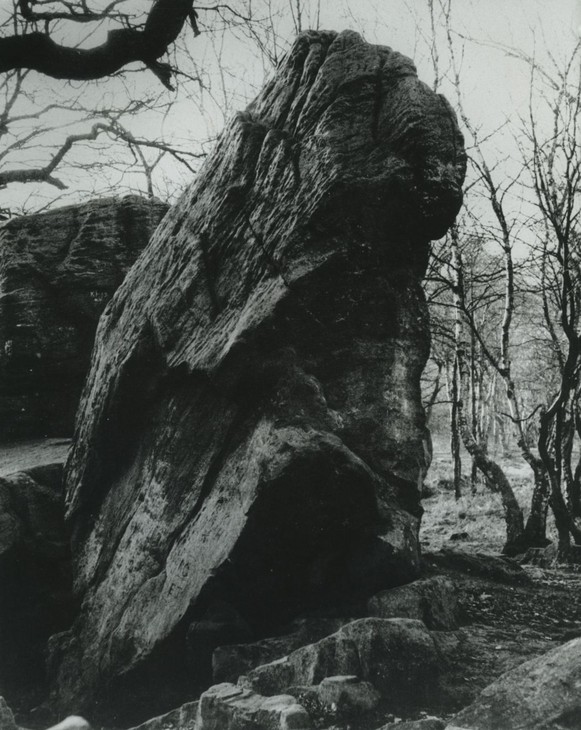
John Hedgecoe
Adel Crag
© The Henry Moore Foundation. All Rights Reserved
Fig.17
John Hedgecoe
Adel Crag
© The Henry Moore Foundation. All Rights Reserved
Moore started collecting pebbles, shells and bones in the late 1920s and his sketchbooks from the 1930s contain studies of these natural forms, which Moore transformed into figurative studies. Having garnered what he called ‘form-knowledge’ of naturally occurring objects early in his career, Moore was able to utilise those shapes imaginatively in his later sculptures. In 1961 eroded cliffs and rock formations not only provided a point of reference for Two Piece Reclining Figure No.2 but also Stone Memorial 1961–9 (fig.18). Moore created the preliminary maquette for this sculpture in 1961, and the large-scale carving in travertine marble reveals it to be a variation of the cavernous cuboid shape formed by the leg section of the two piece sculpture. According to the filmmaker John Read ‘the comparison between the human figure and the rolling slopes of hills or the worn-down shapes of boulders is inescapable. This blending of human and natural form, this ability to see figures in the landscape, and a landscape in the figures, is Moore’s greatest contribution to sculpture. His works are literally landmarks’.30
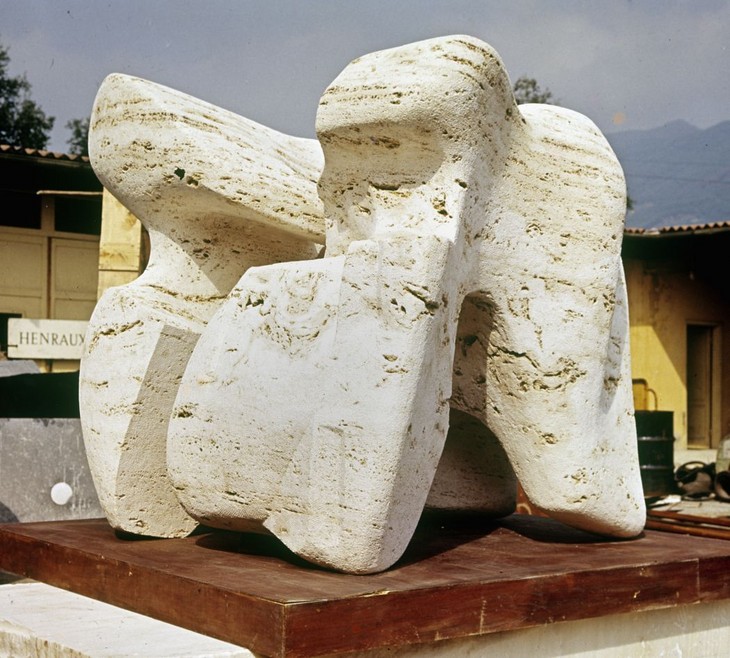
Henry Moore
Stone Memorial 1961–9
Travertine marble
National Gallery of Art, Washington D.C.
© The Henry Moore Foundation. All Rights Reserved
Fig.18
Henry Moore
Stone Memorial 1961–9
National Gallery of Art, Washington D.C.
© The Henry Moore Foundation. All Rights Reserved
For the critic Peter Fuller, Moore’s elision of the human (mainly female) body with landscape was not unique, but was part of a long-standing English Romantic tradition. Romanticism was an early nineteenth-century literary and artistic movement that had ‘a new intuition for the primal power of the wild landscape, the spiritual correspondence between Man and Nature, and the aesthetic principles of “organic” form’.31 To support his claim Fuller cited the Victorian art historian John Ruskin, who, in championing earlier Romantic artists such as J.M.W. Turner, saw mountain peaks as ‘heaving bosoms and exulting limbs, with clouds drifting like hair from their bright foreheads’.32
During the 1930s artists including Eric Gill and critics such as Adrian Stokes invoked Ruskin’s beliefs in the pre-eminence of nature and the social function of art in their own work, despite the fact that other contemporary artists disregarded his influence.33 According to Fuller, these ideas came to fruition in the post-war period in the work of Moore, Paul Nash and Graham Sutherland, who formed an ‘ill-defined but influential British neo-Romantic movement ... characterised by a desire to reaffirm a sense of the British landscape and tradition at a time when these things were under threat’.34 In 1942 these artists were included in John Piper’s book British Romantic Artists, in which Moore was identified as an artistic descendent of John Constable and William Blake.35 Moore encouraged these associations by observing that the Romantic poet William Wordsworth ‘often personified objects in nature and gave them the human aspect, and personally I have done rather the reverse process in sculptures. I’ve often found that by taking formal ideas from landscape, and putting them into my sculpture I have as it were, related a human figure to a mountain, and so got the same effect as a metaphor’.36 Moore’s reference to ‘metaphor in poetry’ in his 1961 statement to Butlin may have stemmed from these earlier discussions about Romanticism.
Moore and classicism
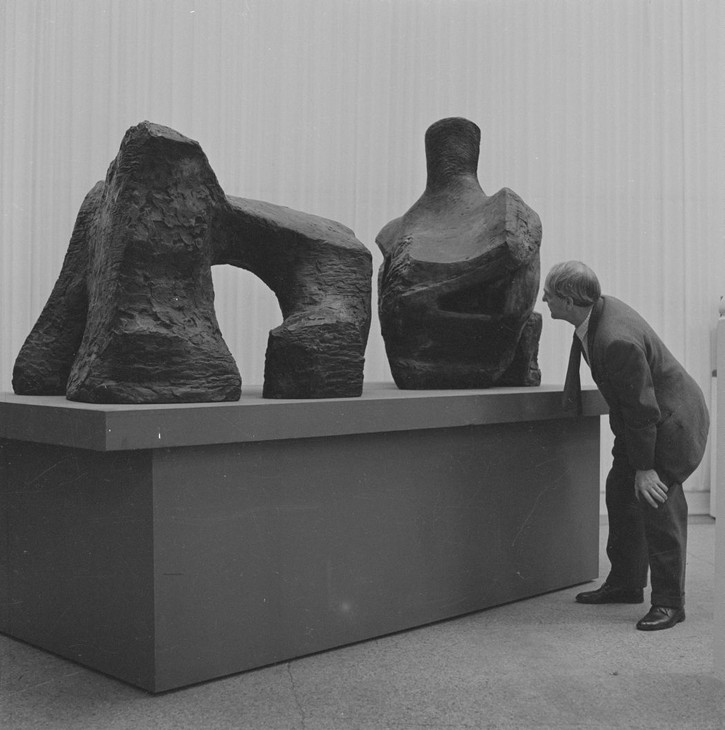
Henry Moore examining Two Piece Reclining Figure No.2 at the Whitechapel Gallery 1960
© The Henry Moore Foundation. All Rights Reserved
Fig.19
Henry Moore examining Two Piece Reclining Figure No.2 at the Whitechapel Gallery 1960
© The Henry Moore Foundation. All Rights Reserved
the most successful of his works to date. They are made in bronze, but in sculptural terms they are moth modelled and hewn, as the geological stratification they suggest is both eroded and fractured. The anthropomorphism is so balanced that the play between the human scale and the rock scale is never dissipated by visual adjustment. Their human scale is heroic, so the transposition is almost immediate.39
Sutton’s reference to ancient Greek sculpture was also made by David Thompson in his review of the exhibition for the Times. Thompson identified landscape and Greek antiquity as the two sources underpinning Moore’s two-piece sculptures:
The imaginative scale of these reclining figures is huge by virtue of the ruthless boldness with which Moore has cut each one in two. The forms are those of landmasses that have survived the most violent ravages of the elements, their essential unity indestructible even when torn apart. And the heroic aspect of the conception is further deepened in both instances by reference in the figure itself to the ‘Ilissus’ from the Parthenon in the British Museum.40
Moore had been a frequent visitor to the British Museum as a student during the 1920s and was very familiar with its collection of ancient Greek statuary. In addition, his first and only visit to Greece in 1951 had an enormous impact on his work, inspiring a series of sculptures of ‘classical’ draped women (see Draped Reclining Woman 1957–8, Tate T06825). Thompson’s description of the two-piece sculptures as ‘heroic’ seems to align Two Piece Reclining Figure No.2 not only with the subject of the river god but with the damaged yet unmarred state of the ancient Greek statue.41 Similarly, in 1973 the critic John Russell implied that Moore’s two-piece sculptures possessed a heroic aspect: ‘fragmentary and ruinous as is the condition of these huge carcasses, their aspect is not one of collapse. They are never merely inert.’42
In 2000 the art historian Roger Cardinal developed these ideas, arguing that however compelling it is to interpret Moore’s two-piece sculptures with reference to nineteenth-century French painting and natural rock formations, ‘they are not necessarily absolute’.43 Like Thompson, Cardinal suggested that ‘there is finally the almost inescapable comparison with the amputated legs of Classical Greek figures, and most especially those from the Parthenon Pediments’.44 According to Cardinal the fragmented figurative sculptures of ancient Greece provided the catalyst for Moore’s renewed interest in the multi-part sculptural form. In 1968 Moore himself, almost incidentally, made this same observation:
The space between the two parts has to be exactly right. It’s as though one was putting together the fragments of a broken antique sculpture in which you have, say, only the knee, a foot and the head. In the reconstruction the foot would have to be the right distance from the knee, and the knee the right distance from the head, to leave room for the missing parts – otherwise you would get the wrong proportioned figure. So, in these two-piece and three-piece sculptures the space between the pieces is a vital part of the sculpture.45
While Cardinal acknowledged that ‘it may seem far fetched to focus so dramatically upon a single formal coincidence’, he nonetheless proposed that Moore’s two-piece sculptures demonstrated his engagement with an ‘aesthetic of the ruinous’.46
Acquisition by Tate
Until 1960 the Tate Gallery held only thirteen sculptures by Henry Moore in its collection. Acquisitions of Moore’s work had been hindered first by J.B. Manson, Tate’s director between 1930 and 1938, who disliked modern art and informed Tate trustee Robert Sainsbury that ‘Over my dead body will Henry Moore ever enter the Tate’,47 and then by Moore’s appointment as a trustee of the gallery, a post which he held between 1941 and 1948, and then between 1949 and 1956.48 However, by the late 1950s the trustees of the gallery were keen to expand the gallery’s holdings of his work.
The Friends of the Tate Gallery acquired six sculptures by Moore, including Working Model for Unesco Reclining Figure 1957 (Tate T00390), during the summer of 1960 and presented them to the gallery in November that year.49 This acquisition happened to coincide with Moore’s exhibition at the Whitechapel Gallery, which opened to the public on 26 November. The critic Adrian Stokes had attended a preview of the exhibition on 22 November, and the next day wrote to John Rothenstein, director of the Tate:
I spent nearly all yesterday in the Whitechapel Gallery + came to the firm conclusion, supported by others, that Divided Form 2 on the right of a, to inc, unexampled richness, was the height of Moore’s achievement + is altogether unsurpassed. I understand from him that only one of the castings remains unallotted of this most recent work: and so, if, in spite of the Tate’s richness of Moore’s to which the Unesco is now added, this later sculpture should be felt to be something that must not on any account be missed, then there may not be much time to be lost.
For me, the only thing in this tremendous exhibition that approaches the magnitude of Divided Form 2, is Divided Form I.50
For me, the only thing in this tremendous exhibition that approaches the magnitude of Divided Form 2, is Divided Form I.50
Although the sculpture was titled Reclining Figure II (Two Piece) in the catalogue for the Whitechapel exhibition, it is clear that the sculpture mentioned by Stokes was in fact Two Piece Reclining Figure No.2. There is no record of further correspondence between Stokes and Rothenstein regarding Stokes’s suggestion that the Tate acquire the sculpture, although it is likely that discussions took place. On 16 December 1960 Rothenstein wrote to Moore, stating:
I am writing to tell you that at their meeting yesterday the Trustees decided to purchase your Divided Form 2. They immensely appreciated your generosity in reducing the price from £7,000 to £5,000. This bronze will be a tremendous accession to your representation at the Gallery, and I propose to put it on view at the same time as the other works that we are acquiring.
I should like to take this opportunity of expressing my own pleasure at the prospect of having Divided Form 2 in the Tate. My pleasure is greater in that I felt, when we last spoke on the telephone, that this, of all your recent works, was the one which you thought would represent you best.51
I should like to take this opportunity of expressing my own pleasure at the prospect of having Divided Form 2 in the Tate. My pleasure is greater in that I felt, when we last spoke on the telephone, that this, of all your recent works, was the one which you thought would represent you best.51
From the date of Rothenstein’s letter it is evident that he and the trustees did indeed move quickly, as Stokes had suggested, to secure Two Piece Reclining Figure No.2 for the gallery. The sculpture was paid for with funds provided by the government for the development of the collection, known as ‘Grant-in-Aid’. Although the six works presented by the Friends where scheduled for delivery on 2 May 1961, in March that year Moore informed Tate’s new director Norman Reid that ‘I won’t have the latest piece, the Two-Piece Reclining Figure No.II – as the Tate came rather late on the list, and the bronze founder won’t have the cast ready by then’.52 The sculpture would not arrive at the gallery until February 1962.53
Since entering the Tate collection Two Piece Reclining Figure No.2 has been on regular display at the gallery. It was included in the exhibition marking Moore’s eightieth birthday in 1978, and was also part of a special memorial display held in September 1986 following Moore’s death a month earlier.
Two Piece Reclining Figure No.2 was cast in an edition of seven plus one artist’s copy. Although Tate’s version was one of the last in the edition to be cast, it is numbered ‘Moore 3/7’ on the lower edge of the torso section. The full-size plaster is housed in the collection of the Art Gallery of Ontario, Toronto, and other bronzes are held at the Henry Moore Foundation, Perry Green; the Saint Louis Art Museum, Saint Louis; the National Galleries of Scotland, Edinburgh; the Rijksmuseum Kröller-Müller, Otterlo; the Museum of Modern Art, New York; and the Modern Art Museum of Fort Worth. One cast is believed to be held in a private collection.
Alice Correia
July 2013
Notes
Henry Moore cited in Carlton Lake, ‘Henry Moore’s World’, Atlantic Monthly, vol.209, no.1, January 1962, p.44.
See Alan G. Wilkinson, Henry Moore Remembered: The Collection at the Art Gallery of Ontario in Toronto, Toronto 1987, p.194.
Phillip King, ‘Two Piece Reclining Figure No.2’, in David Mitchinson (ed.), Celebrating Moore: Works from the Collection of the Henry Moore Foundation, London 2006, p.265.
Moore cited in Donald Hall, ‘Henry Moore: An Interview by Donald Hall’, Horizon, November 1960, reprinted in Alan Wilkinson (ed.), Henry Moore: Writings and Conversations, Aldershot 2002, p.226.
Henry Moore cited in ‘Henry Moore Talking to David Sylvester’, 7 June 1963, transcript of Third Programme, BBC Radio, broadcast 14 July 1963, p.10, Tate Archive TGA 200816.
Henry Moore, letter to Martin Butlin, 13 April 1961, Tate Artist Catalogue File, Henry Moore, A23945.
Henry Moore, ‘Two-Piece Reclining Figures 1959 and 1960’, artist’s statement sent to Martin Butlin, 13 April 1961, Tate Artist Catalogue File, Henry Moore, A23945, reprinted in Mary Chamot, Dennis Farr and Martin Butlin, Tate Gallery Catalogues: The Modern British Paintings, Drawings and Sculpture, London 1964, vol.2, p.28.
Alan Bowness, ‘Introduction’, in Alan Bowness (ed.), Henry Moore. Volume 4: Complete Sculpture 1964–73, London 1977, p.8.
Moore, ‘Two-Piece Reclining Figures 1959 and 1960’, 13 April 1961, Tate Artist Catalogue File, Henry Moore, A23945.
Peter Fuller, ‘Henry Moore: An English Romantic’, in Susan Compton (ed.), Henry Moore, exhibition catalogue, Royal Academy of Arts, London 1988, p.39.
See John Hedgecoe (ed.), Henry Moore: My Ideas, Inspiration and Life as an Artist, London 1986, p.35.
See Fiona Russell, ‘John Ruskin, Herbert Read and the Englishness of British Modernism’, in David Peters Corbett, Ysanne Holt and Fiona Russell (eds.), The Geographies of Englishness: Landscape and the National Past 1880–1940, New Haven 2002, pp.303–21.
Henry Moore cited in ‘Art and Life: V.S. Pritchett, G. Sutherland, K. Clark, H. Moore in Discussion’, Listener, 13 November 1941, pp.657–9, reprinted in Philip James (ed.), Henry Moore on Sculpture, London 1966, p.76.
For the sculpture of the river-god known as ‘Ilissos’ see http://www.britishmuseum.org/explore/highlights/highlight_objects/gr/f/figure_of_a_river-god.aspx , accessed 6 March 2014.
Roger Cardinal, ‘Henry Moore: In the Light of Greece’, in Henry Moore: In the Light of Greece, exhibition catalogue, Basil and Elise Goulandris Foundation Museum of Contemporary Art, Andros 2000, p.47.
Related essays
- Scale at Any Size: Henry Moore and Scaling Up Rachel Wells
- Ambivalence and Ambiguity: David Sylvester on Henry Moore Martin Hammer
- Henry Moore: The Plasters Anita Feldman
- Erich Neumann on Henry Moore: Public Sculpture and the Collective Unconscious Tim Martin
- Henry Moore's Approach to Bronze Lyndsey Morgan and Rozemarijn van der Molen
Related catalogue entries
Related material
Related reviews and articles
- Keith Sutton, ‘Henry Moore at Whitechapel’ Listener, December 8 1960.
How to cite
Alice Correia, ‘Two Piece Reclining Figure No.2 1960, cast 1961–2 by Henry Moore OM, CH’, catalogue entry, July 2013, in Henry Moore: Sculptural Process and Public Identity, Tate Research Publication, 2015, https://www

